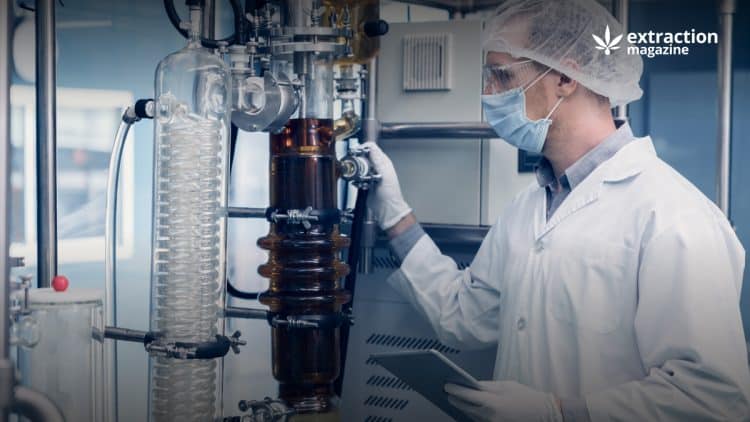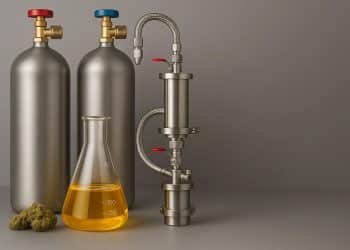Imagine a cup of tea. What starts out as dried leaves becomes a satisfying drink when hot water is added. Depending on how that tea is taken, milk or lemon juice may be added to increase the flavor, and others may choose to add a cube or two of sugar to sweeten the drink even further. Once all of these ingredients are mixed together, the tea bag is removed and the flavors mix together seamlessly. This sounds simple, but what if we would like to reverse this process and we would like to remove the tea leaves fully infused into the drink? It would require a more complicated operation than just lifting them out of the cup.
We should perform a distillation. Distillation is a process that allows all the additional liquids or compounds to be removed from the solution. In some cases, distillation may be used to get the solvents back in the pure form, like distilling the water back in the example with tea, or could also be used to extract the physical material within the solvent. With this in mind, there are two ways to distill a solution, and while the procedures are similar they can both be utilized in different ways.
How to Perform Simple Distillation
To explain simple distillation, the easiest way to take a real world example. [1] In order to remove the salt from seawater, a simple distillation is the easiest way to do so. [2] This solution consists of two components: salt and water. Both of these components are usable, but the solvent, the water, needs to be separated from the physical material, the salt. Using a simple set-up, it is possible to isolate these materials in a few basic steps. First, the salty water is placed into a round bottom flask. [3] From there, the solution is boiled, allowing the liquid to evaporate. The water vapor separates from the solution and is siphoned off into a separate container to condensate back into its liquid form. This leaves pure salt in one container, and distilled water in the other.
Using salty water as our hypothetical solution means water as a solvent reaches its boiling point of 100 °C, and the components separate from the mixture. This is the basic technique used to desalinate saltwater, and helps provide potable water from salinated sources. As the name would suggest, the distillation procedure works very well for solutions that are simple. However, what if the solution is more complex, and consists of multiple solvents? In this instance, fractional distillation presents a slightly different technique to achieve the same end result.
The Difference with Fractional Distillation
Simple distillation is effective for isolating components in solutions with drastically different boiling points. In the previous example, water boils at 100 °C, and salt reaches a melting point of 801 °C. [4] But what happens when the boiling points are much closer to each other? It becomes much harder to isolate each individual part of the solution as one component may evaporate with the other.
Take alcohol for example. [5] Any alcoholic beverages designed for consumers must first go through fractional distillation to isolate the ethanol, fermented plant material, and water from the initial solution. The solution first goes through a maceration process, known as fermentation, where the sugars and starches in the plant material are converted into ethanol.[6] This solution typically comes in the form of a mash. Once the ethanol is ready, any harmful substances and excess plant material must be removed to convert the solution into a liquid that is safe to drink. To do this, the solution is added to the base of the flask, similar to simple distillation. The equipment is slightly different, though, primarily relying on a beaker with a fractionating column instead of a standard neck. [7] Because ethanol has a boiling point of 78 °C, compared to water’s boiling point of 100 °C, the heating of the solution must be done in stages. If simple distillation were employed, it is possible that too much water vapor may combine with the ethanol.
To avoid this, the beaker is first heated to 78 °C, allowing the ethanol to evaporate. Any water vapor that comes with the ethanol is trapped in the fractionating column, where it condensates and recombines with the solution. The ethanol is isolated in a separate container before raising the temperature again to 100 °C to effectively distill the remaining water out of the plant mash. Depending on the alcoholic content of the finished product, the heating times and distillation may vary to determine the concentration of ethanol.
This process is similar to simple distillation, but fractional distillation involves more steps to allow greater efficiency in the distillation process.
Advantages and Effectiveness of Each Process
Simple and fractional distillation are two procedures that work on the same physical principles of evaporation and condensation to isolate materials within a solution. Both can require round bottom flasks to heat the solvents to their boiling points, but the main difference between the two comes down to the components within the solution. With this in mind, there are advantages to each system, but it may depend on what is being distilled and which solvents are employed.
In terms of simple distillation, the costs tend to be slightly lower. This is because the solvent extraction has only to be performed once, and the equipment used tends to be simpler. With this in mind, it is possible to perform simple distillation on a solution with more than one solvent, but only if their boiling points are dramatically different from each other. Because of this, fractional distillation provides an advantage in more efficiently separating solutions regardless of their boiling points. Fractional distillation needs to be performed in stages, allowing each component to be completely removed from the starting solution. The downside to this is that it extends the distillation time and thus the energy needed to heat the solution.
However, if the solution is exceedingly complex, fractional distillation may ultimately prove more beneficial as it can lead to a better reclamation of each component parts. Depending on what is being distilled, this may allow for more recycled solvents in the long run.
References:
- Danilov, R. Yu, F. B. Petlyuk, and L. A. Serafimov. “Minimum-reflux regime of simple distillation columns.” Theoretical Foundations of Chemical Engineering 41 (2007): 371-383.
- Stewart, Melissa. “Tapping Saltwater.” ChemMatters (2002).
- Kahl, Alandra, Danita Heller, and Kim Ogden. “Constructing a simple distillation apparatus to purify seawater: A High school chemistry experiment.” Journal of Chemical Education 91.4 (2014): 554-556.
- Yamada, M., et al. “Melting point and supercooling characteristics of molten salt.” Thermochimica acta 218 (1993): 401-411.
- Onuki, Shinnosuke, et al. “Ethanol production, purification, and analysis techniques: a review.” 2008 Providence, Rhode Island, June 29–July 2, 2008 (2008): 1.
- Tambun, R., V. Alexander, and Y. Ginting. “Performance comparison of maceration method, soxhletation method, and microwave-assisted extraction in extracting active compounds from soursop leaves (Annona muricata): A review.” IOP Conference Series: Materials Science and Engineering. Vol. 1122. No. 1. IOP Publishing, 2021.
- Ghyselbrecht, Karel, et al. “Stripping and scrubbing of ammonium using common fractionating columns to prove ammonium inhibition during anaerobic digestion.” International Journal of Energy and Environmental Engineering 9 (2018): 447-455.












